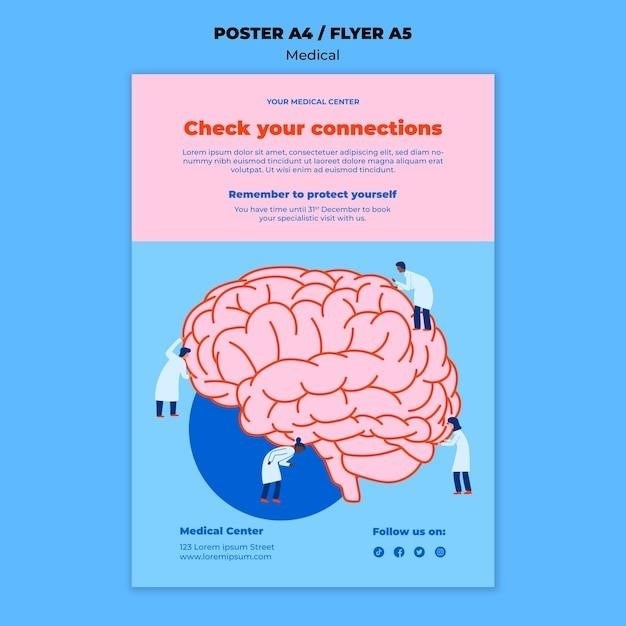What is Neuroplasticity?
Neuroplasticity, also known as neural plasticity or brain plasticity, describes the brain’s remarkable ability to reorganize its structure and function in response to experiences, learning, and even injury. This adaptive capacity allows for continuous change and improvement throughout life.
Defining Brain Plasticity
Brain plasticity, or neuroplasticity, signifies the brain’s inherent capacity for structural and functional reorganization. Unlike once-held beliefs of a static, unchanging organ, research reveals the brain’s dynamic nature, constantly adapting to internal and external stimuli. This adaptability manifests in various ways, including changes in synaptic strength, the formation of new neural connections (synaptogenesis), and even the generation of new neurons (neurogenesis), particularly in specific brain regions. These modifications underpin learning, memory formation, and recovery from neurological injuries. The brain’s plasticity is not uniform across all brain areas or throughout life; certain regions exhibit greater plasticity than others, and this capacity generally diminishes with age, although it remains present to a significant degree even in older adults. Understanding the mechanisms and limits of brain plasticity is crucial for developing effective treatments for neurological disorders and optimizing learning and cognitive enhancement strategies.
Mechanisms of Neuroplasticity
Neuroplasticity’s intricate mechanisms involve a complex interplay of molecular and cellular processes. Synaptic plasticity, a cornerstone of this process, refers to the strengthening or weakening of connections between neurons (synapses). Long-term potentiation (LTP) strengthens synapses, enhancing signal transmission, while long-term depression (LTD) weakens them. These changes are driven by alterations in neurotransmitter release, receptor sensitivity, and structural modifications at the synapse. Neurogenesis, the birth of new neurons, contributes to plasticity, primarily in specific brain areas like the hippocampus, crucial for learning and memory. Furthermore, dendritic branching, the growth of new dendrites (the receiving parts of neurons), expands the neuron’s capacity for connections. Glial cells, once considered merely supportive, actively participate, influencing synaptic function and neuronal survival. These mechanisms, often acting in concert, allow the brain to refine its circuitry, adapt to new information, and recover from damage, highlighting the brain’s remarkable capacity for self-modification.

Factors Influencing Brain Change
Environmental enrichment and experiences significantly shape brain structure and function, impacting neuroplasticity. Learning, particularly through focused training, promotes neural adaptation.
Environmental Enrichment
Studies consistently demonstrate that enriched environments profoundly impact brain plasticity. Animals housed in complex environments with abundant sensory stimulation, social interaction, and opportunities for exploration exhibit enhanced cognitive abilities and structural brain changes. These changes include increased neurogenesis (the birth of new neurons), synaptogenesis (formation of new synapses), and dendritic branching (growth of neuronal connections). The enhanced complexity of neural networks in enriched environments contributes to improved learning, memory, and overall cognitive function. Conversely, impoverished environments lacking stimulation lead to reduced brain plasticity and impaired cognitive performance. This highlights the crucial role of environmental factors in shaping brain development and lifelong adaptability. The findings underscore the importance of providing stimulating environments for optimal brain health and cognitive enhancement across the lifespan.
Experience-Dependent Plasticity (e.g., Music Training)
Experience-dependent plasticity showcases how specific activities shape brain structure and function. Music training provides a compelling example. Studies reveal that musicians, particularly those starting at a young age, exhibit structural and functional brain differences compared to non-musicians. These differences often involve areas related to auditory processing, motor control, and memory. For instance, musicians typically show increased gray matter volume in brain regions associated with auditory processing and motor skills, reflecting the neural adaptations resulting from years of musical practice. Moreover, functional imaging studies reveal enhanced neural efficiency and connectivity within relevant brain networks. These findings demonstrate how intensive, focused training can lead to significant, experience-dependent brain plasticity, reshaping the brain’s architecture and improving cognitive performance in specific domains.
Neuroplasticity and Neurological Disorders
Neuroplasticity plays a crucial role in recovery from neurological disorders. Understanding its mechanisms is vital for developing effective therapies.
Parkinson’s Disease
Parkinson’s disease, a neurodegenerative disorder, significantly impacts motor skills and cognitive function. Research indicates that neuroplasticity can be harnessed to alleviate some symptoms. Studies involving enriched environments and intensive rehabilitation programs have shown promising results in improving motor function and quality of life for individuals with Parkinson’s. These interventions aim to stimulate neural reorganization and compensate for the loss of dopaminergic neurons, a hallmark of the disease. While the extent of neuroplasticity in advanced Parkinson’s remains an area of active investigation, current research suggests its potential for therapeutic interventions. Further research exploring the mechanisms and limitations of neuroplasticity in Parkinson’s disease is crucial for developing more effective treatments. This includes investigating the potential of non-invasive brain stimulation techniques to enhance neuroplasticity and promote functional recovery.
Stroke Rehabilitation
Stroke rehabilitation leverages the brain’s capacity for neuroplasticity to recover lost function. Following a stroke, the brain undergoes significant reorganization, with surviving neurons forming new connections to compensate for damaged areas. Rehabilitation therapies, such as constraint-induced movement therapy (CIMT) and intensive physical therapy, actively promote this reorganization. CIMT, for example, restricts the use of the unaffected limb to force the use of the impaired limb, driving neuroplastic changes. The timing and intensity of rehabilitation are crucial factors influencing the extent of recovery. Early intervention maximizes the brain’s plasticity window, leading to better outcomes. Neuroplasticity research in stroke recovery also involves advanced imaging techniques to monitor brain changes during rehabilitation, providing insights into the effectiveness of different interventions and guiding personalized treatment plans. This targeted approach aims to optimize functional recovery and improve the quality of life for stroke survivors.
Aphasia Treatment
Aphasia, a language disorder often resulting from stroke, presents a compelling case study in neuroplasticity. Treatment approaches aim to harness the brain’s ability to reorganize language networks. Traditional methods like speech therapy focus on repetitive practice and targeted exercises to stimulate language recovery. However, recent research highlights the importance of integrating technology into aphasia therapy. Computer-assisted language training programs offer personalized feedback and adaptive exercises, effectively engaging the brain’s plasticity. Furthermore, studies explore non-invasive brain stimulation techniques, such as transcranial magnetic stimulation (TMS), to enhance neuroplasticity and improve language outcomes. These methods aim to modulate brain activity in areas involved in language processing, thereby facilitating functional recovery. The efficacy of these treatments is assessed using various measures, including language tests and brain imaging techniques, to monitor changes in brain activity and language proficiency. A deeper understanding of neuroplasticity in aphasia is vital for developing more effective and personalized therapeutic interventions.
Research Methods in Neuroplasticity
Advanced neuroimaging techniques, such as fMRI and EEG, allow researchers to observe brain activity and structural changes during learning and recovery. Transcriptomic studies offer insights into gene expression patterns.
fMRI and Brain Imaging
Functional magnetic resonance imaging (fMRI) is a crucial tool in neuroplasticity research. fMRI measures brain activity by detecting changes in blood flow, providing real-time visualization of brain regions involved in specific tasks or during recovery from injury. This non-invasive technique allows researchers to observe how brain activation patterns change with learning, therapy, or environmental enrichment. By comparing fMRI scans before and after interventions, scientists can directly assess the structural and functional reorganization of the brain. The high spatial resolution of fMRI enables precise identification of activated brain areas, allowing for a detailed understanding of the neural networks involved in various cognitive and motor functions. Furthermore, advancements in fMRI techniques, such as resting-state fMRI, provide insights into intrinsic brain connectivity and network dynamics even in the absence of explicit tasks. This offers valuable information about the brain’s intrinsic capacity for reorganization and its response to various stimuli. The integration of fMRI with other brain imaging modalities, such as diffusion tensor imaging (DTI), further enhances our understanding of structural changes associated with neuroplasticity. Combining these techniques provides a comprehensive picture of both functional and anatomical modifications within the brain.
Transcriptomic Studies
Transcriptomic studies offer a powerful molecular approach to understanding neuroplasticity. These studies analyze the complete set of RNA transcripts in a cell or tissue, providing a detailed snapshot of gene expression patterns. By examining changes in gene expression following interventions such as learning or therapy, researchers can identify specific genes and pathways involved in the brain’s adaptive responses. This approach complements brain imaging techniques by providing a molecular-level understanding of the mechanisms underlying structural and functional changes. Transcriptomic studies can reveal subtle alterations in gene regulation that may not be detectable through other methods, offering valuable insights into the intricate molecular processes of neuroplasticity. The analysis of gene expression profiles can help pinpoint specific molecular targets for therapeutic interventions aimed at enhancing brain plasticity. Furthermore, comparing transcriptomic data from different brain regions or cell types provides a more comprehensive understanding of the cell-type specific responses to experience and injury. Advanced transcriptomic techniques, such as single-cell RNA sequencing, allow for even greater resolution, enabling the study of gene expression at the individual cell level.

Therapeutic Applications of Neuroplasticity
Harnessing the brain’s capacity for change, therapeutic approaches like constraint-induced movement therapy and cognitive rehabilitation aim to promote functional recovery after neurological injury or disease, improving quality of life.
Constraint-Induced Movement Therapy
Constraint-induced movement therapy (CIMT) is a rehabilitation technique leveraging neuroplasticity to improve motor function in individuals with stroke or other neurological conditions causing upper limb weakness. The core principle involves constraining the unaffected limb, forcing the patient to use the impaired limb for daily activities. This intensive, repetitive use promotes cortical reorganization, strengthening neural pathways associated with the affected limb. Studies have shown significant improvements in motor skills, dexterity, and independence following CIMT. The therapy’s effectiveness stems from its ability to drive adaptive changes within the brain, rewiring neural networks to compensate for damage and enhance motor control. While highly effective for some, CIMT’s success is dependent on factors such as the severity of the impairment, patient motivation, and the intensity of the therapy regimen. Further research continues to refine CIMT protocols and expand its applications to a broader range of neurological disorders.
Cognitive Rehabilitation
Cognitive rehabilitation targets cognitive impairments resulting from brain injury or disease, harnessing the brain’s capacity for plasticity to improve function. This multifaceted approach employs various techniques tailored to the individual’s specific deficits. These may include memory training exercises, problem-solving strategies, attention-enhancing activities, and language retraining. The therapeutic process often involves a collaborative effort between therapists, patients, and family members. Success hinges on the patient’s active engagement and consistent practice. Cognitive rehabilitation aims to not only restore lost skills but also to compensate for persistent deficits by teaching alternative strategies. The effectiveness of cognitive rehabilitation is supported by numerous studies demonstrating improved cognitive performance, enhanced daily living skills, and improved quality of life. Ongoing research explores novel approaches and technological advancements to further optimize treatment outcomes and expand the reach of these beneficial interventions.